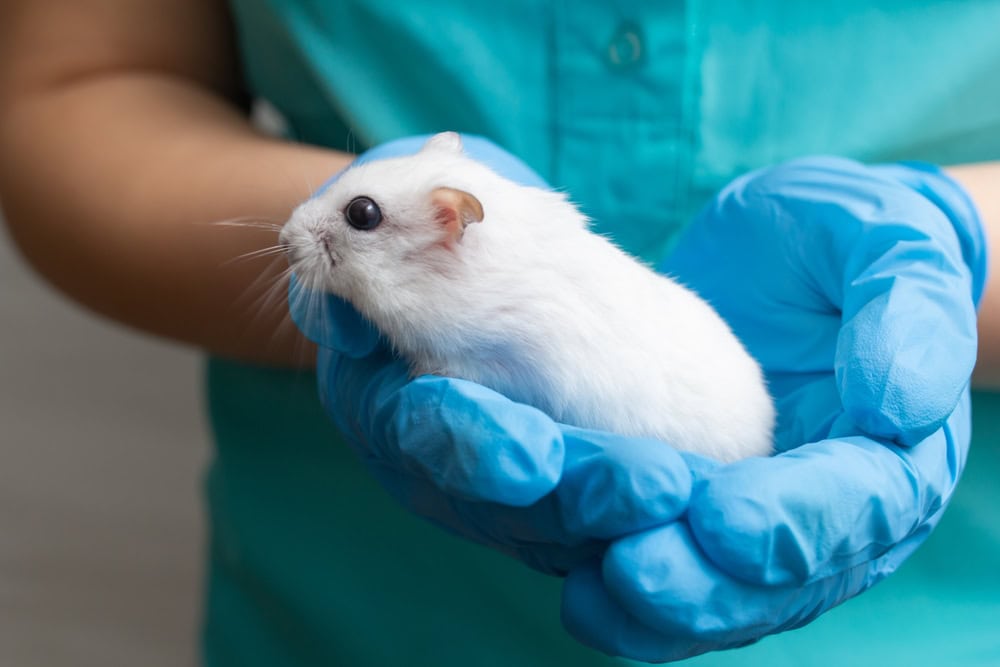
The information is current and up-to-date in accordance with the latest veterinarian research.
Learn more »
Pocket pets like hamsters are common household pets. And generally, hamsters are easy to keep; however, that doesn’t mean hamsters do not need veterinary care! One illness that plagues hamsters is the development of tumors and cancer. Continue reading to learn more about how these conditions are diagnosed in hamsters and how to properly care for your small companion.
What Are Tumors and Cancer in Hamsters?
Before diving into the different types of tumors and cancers hamsters tend to develop, it is worthwhile to review the terminology, as it can be confusing.
To start, neoplasia is the abnormal proliferation of cells. What forms as a result of abnormal cell production is referred to as a tumor or a mass. Neoplasia can be malignant or benign.
Image Credit: Seattle Roll, Shutterstock
Malignant Neoplasia
Neoplasia that can be invasive or can spread to other locations in the body is referred to as malignant neoplasia or cancer. Not all types of cancer form a mass or tumor. An example of a cancer that doesn’t form a mass is leukemia, which causes an abnormal proliferation of white blood cells.
Benign Neoplasia
Although benign growths are less invasive and are not cancerous, they still can pose risks to the patient and have systemic ramifications. Their quality of life and mobility may be severely impacted, depending on where a neoplasm is located.
What Are the Signs of Neoplasia?
Visible tumor or growth
Lethargy
Weakness
Weight loss
Reduced appetite
Change in normal behavior
Pain
Diagnosing Neoplasia in Hamsters
Image Credit: v-svirido, Shutterstock
Similar to dogs and cats, the first step in identifying a growth is to schedule an appointment with your veterinarian. A neoplasm can often be differentiated as cancerous or non-cancerous through closer evaluation of the cells making up the mass.
A fine needle aspirate involves aspirating cells from the tumor using a needle and evaluating the cells under the microscope. This is a non-invasive technique that can be done in hospitals, often on un-sedated animals. A more definitive diagnosis is achieved through a biopsy. This involves looking at a large population of cells that have been removed surgically from the tumor, either through the removal of the entire mass or a tissue biopsy. This type of diagnostic is more reliable, as it involves the evaluation of a larger cell population.
Additional diagnostics including bloodwork, radiographs, and ultrasounds may be recommended for your pet as well.
Treating and Caring for a Hamster With Neoplasia
When determining how to treat a neoplastic process in your companion hamster, emphasis must be placed on quality of life. A factor that should be considered is their relatively short life expectancy and their ability to handle interventions.
Some types of neoplasia (cancerous or non-cancerous) can be treated in hamsters through surgical removal, especially if they are external. Internal tumors are significantly more difficult to address due to the hamster’s small size. Small patient sizes can make surgical intervention and recovery challenging.
Chemotherapy and radiation are available options that can be used to treat some types of neoplasia in some animals. This option may not be available to your pet, depending on where and what type of neoplasia is present.
Image Credit: Oleksandrum, Shutterstock
Common Types of Neoplasia in Hamsters
Adrenal Gland Tumors
A study looking at Syrian hamsters suggested that tumors impacting the adrenal glands were the most commonly occurring tumors in both males and females.1 These tumors could be benign (adenoma) or malignant (carcinoma) in nature and lead to an overproduction of steroids. The overproduction of steroids leads to a condition called hyperadrenocorticism or Cushing’s.
Patients with hyperadrenocorticism may experience a pot-bellied appearance, hair loss, and an increase in water intake. Treatment is rarely pursued due to the cost of treatment and the short life expectancy of hamsters in general. Some breeds may be less likely to develop this type of neoplasia; however, at this time, studies are lacking.
Female Reproductive Tumors
In the same study evaluating Syrian hamsters, leiomyoma and endometrial adenocarcinomas were prominent. Adenocarcinomas are malignant and have a high tendency to spread to other locations within the body.
Lymphoma
Lymphoma is the abnormal production of lymphocytes, a particular type of white blood cell, within lymphatic tissue. This condition is common in hamsters. There are several different types of lymphoma, and different portions of the body may be affected, including the liver, gastrointestinal tract, and skin.
Frequently Asked Questions (FAQ)
My Hamster Has a Large Tumor on Their Belly. Is This Painful?
It is important to closely monitor your hamster for signs of discomfort, which may include decreased mobility and changes in behavior. Not all tumors cause discomfort, but the larger the growth gets, the more likely secondary trauma is to occur, leading to pain.
What Do I Need to Consider Prior to Having Surgery Done on My Hamster?
Hamsters can be challenging to perform surgery on due to their small size. The patient’s age should be considered, as well as their quality of life. Is having surgery going to impact your pet’s quality of life negatively or positively?
Image Credit: TShaKopy, Shutterstock
Conclusion
Hamsters are adored pocket pets and can be a beloved addition to your household. Unfortunately, hamsters overall have a short life expectancy when compared to other species, and the risk of cancer increases as the patient ages.
A large portion of hamsters will develop neoplasia during their short lifetime. Although finding a growth can be very scary, keep in mind that not all growths are cancerous. The first step in diagnosing your hamster is scheduling an appointment with your veterinarian.
When moving forward with the care of your hamster, take into consideration how intervention and care could impact your companion’s quality of life. In some cases, allowing a disease to progress naturally may be the best option for your tiny friend.
Featured Image Credit: Dmitriva Irina, Shutterstock






